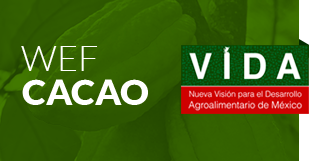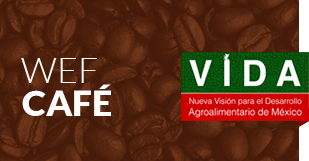 |
|
Opportunities:
Mexican cocoa farmers have the opportunity to double or even triple their production. To achieve these objectives it is necessary to achieve a significant increase in current productivity levels of plantations by incorporating the best agricultural practices, sustainable agricultural practices, training farmers, plantation renewal, incorporating cocoa varieties tolerant to diseases and of high quality, plantation certifications, among others. |
 |
Benefits of Cocoa Certification. Cocoa buyers worldwide pay up to $ 100 USD per ton of certified organic cocoa which significantly raises the income of farmers and their families. Besides ensuring quality in cocoa and fair trade with producers, in addition to preserving the environment. |
|
 |
Environmental Benefits:
The interventions at a production level can make a positive environmental impact while generating economic opportunities for residents. CONANP (National Commission of Natural Protected Areas) has developed projects for the recovery of degraded areas of the Biosphere Reserve of Montes Azules using cocoa as an axis of agroforestry systems. At present the marketing and processing of cocoa at an artisanal level has become the main source of income for indigenous communities in the Reserve. Moreover, the ethno-ecotourism and agrotourism presents real opportunities that simultaneously promote conservation and generates income for cocoa growing communities. |
|
According to USAID promoting cocoa is recommended for being a environmentally friendly farming which protects biodiversity: it is produced in plantations with shades from trees and it is compatible with s diversification of other crops that also require shade from trees and shade itself can be formed with species that have commercial value. |
 |
|
Moreover, traditional systems of cocoa production represent the main forest cover, especially in the state of Tabasco where deforestation is evident and in the Pacific coastal plain of Chiapas, where extensive livestock production has reduced forest cover. This crop has been used successfully by CONANP for the recovery and conservation of forest areas with indigenous communities. Great interest has been shown in promoting this crop in order to support the formation of forested corridors connecting various areas of high biodiversity. This is done by following the recommended regulations to prevent the introduction of new varieties and suggests that the shadow is provided by the forest or jungle in recovery. The environmental benefit of the traditional production of cocoa has been documented by the Rainforest Alliance, where these plantations are used as corridors or areas of temporary establishment of animal species, enabling migration between isolated areas of forest or natural forest. It also notes that several animal species such as monkeys, squirrels, rodents, birds and reptiles, settle permanently in traditional cacao plantations. This was observed directly by USAID team in Tabasco State farms. |
 |
 |
|
With the entry into force of the Kyoto Protocol, there are opportunities for raising revenue through carbon trading, especially with European companies, as countries in that region have ratified the treaty and began to enforce goals reducing carbon emissions. One of the advantages to producers using traditional farming systems under shade and that promote biodiversity, is that payment may be negotiate by carbon capture from companies that produce high carbon emissions and receive royalties based on the ability of its plantations to absorb this element. |
|
Benefits of Mexican cocoa.
The Mexican producer has in its favor a variety of cocoa with a good potential for their genetic quality, ease of conversion to organic cocoa as well as long experience of organization, although this one has to be reinforced.
Economic benefits for producers.
|
 |
|
Demand for chocolate is concentrated in Europe, America and Japan, however the populations of China and India have accelerated their demand in recent years, so that in order to meet this demand global production should rise considerably. |
 |
Social benefits.
Improve the quality of life for farmers and their families, these programs and projects are aimed at producers and low-income farmers. The Foundation is working mainly in the state of Chiapas where 30% of the population lives in extreme poverty and 40% in moderate poverty, representing 70% of the population of this State living in poverty.
By increasing the current production almost tripling it the income triples as well for farmers and their families improving their quality of life.
|
| Cocoa Mexico Foundation works on social programs to uplift and improve the quality of life of farmers and their families through education, training, cooperation to create sustainable communities, protecting the environment and the biodiversity. |







![[en]Hershey's Project / Mexico Cocoa Foundation[/en][es]Proyecto Hershey´s/ Fundación Cacao México[/es] [en]Hershey's Project / Mexico Cocoa Foundation[/en][es]Proyecto Hershey´s/ Fundación Cacao México[/es]](https://cacaomexico.org/wp-content/gallery/galeria/thumbs/thumbs_26.jpg)
![[en]Hershey's Project / Mexico Cocoa Foundation[/en][es]Proyecto Hershey´s/ Fundación Cacao México[/es] [en]Hershey's Project / Mexico Cocoa Foundation[/en][es]Proyecto Hershey´s/ Fundación Cacao México[/es]](https://cacaomexico.org/wp-content/gallery/galeria/thumbs/thumbs_4.jpg)
![[en]Hershey's Project / Mexico Cocoa Foundation[/en][es]Proyecto Hershey´s/ Fundación Cacao México[/es] [en]Hershey's Project / Mexico Cocoa Foundation[/en][es]Proyecto Hershey´s/ Fundación Cacao México[/es]](https://cacaomexico.org/wp-content/gallery/galeria/thumbs/thumbs_57.jpg)
![[en]Hershey's Project / Mexico Cocoa Foundation[/en][es]Proyecto Hershey´s/ Fundación Cacao México[/es] [en]Hershey's Project / Mexico Cocoa Foundation[/en][es]Proyecto Hershey´s/ Fundación Cacao México[/es]](https://cacaomexico.org/wp-content/gallery/galeria/thumbs/thumbs_13_0.jpg)
![[en]Visit Project[/en][es]Visita Proyecto[/es] [en]Visit Project[/en][es]Visita Proyecto[/es]](https://cacaomexico.org/wp-content/gallery/galeria/thumbs/thumbs_49_0.jpg)
![[en]Visit Project[/en][es]Visita Proyecto[/es] [en]Visit Project[/en][es]Visita Proyecto[/es]](https://cacaomexico.org/wp-content/gallery/galeria/thumbs/thumbs_54_0.jpg)

























